If you’re a dedicated Goonhammer Historicals reader (thank you!) then you’ve seen some of my previous posts on the US-Mexico War. Even now, two years into the project, I’m more interested than ever in the conflict. I’m currently working on scenarios to make a Pint Sized Campaign, as well as making some tweaks to the setting rules that are presented in the list from TFL. Today’s article will detail the two opposing forces, new rules I have implemented in the campaign, and then a quick battle report.
For this game and the campaign I’m planning I’m using the So Far From God supplement from TooFatLardies. This is easily my favorite supplement produced by TFL, with huge respect paid to the Mexican troops who fought hard at a disadvantage, countering some of the traditional American-centric commentary.
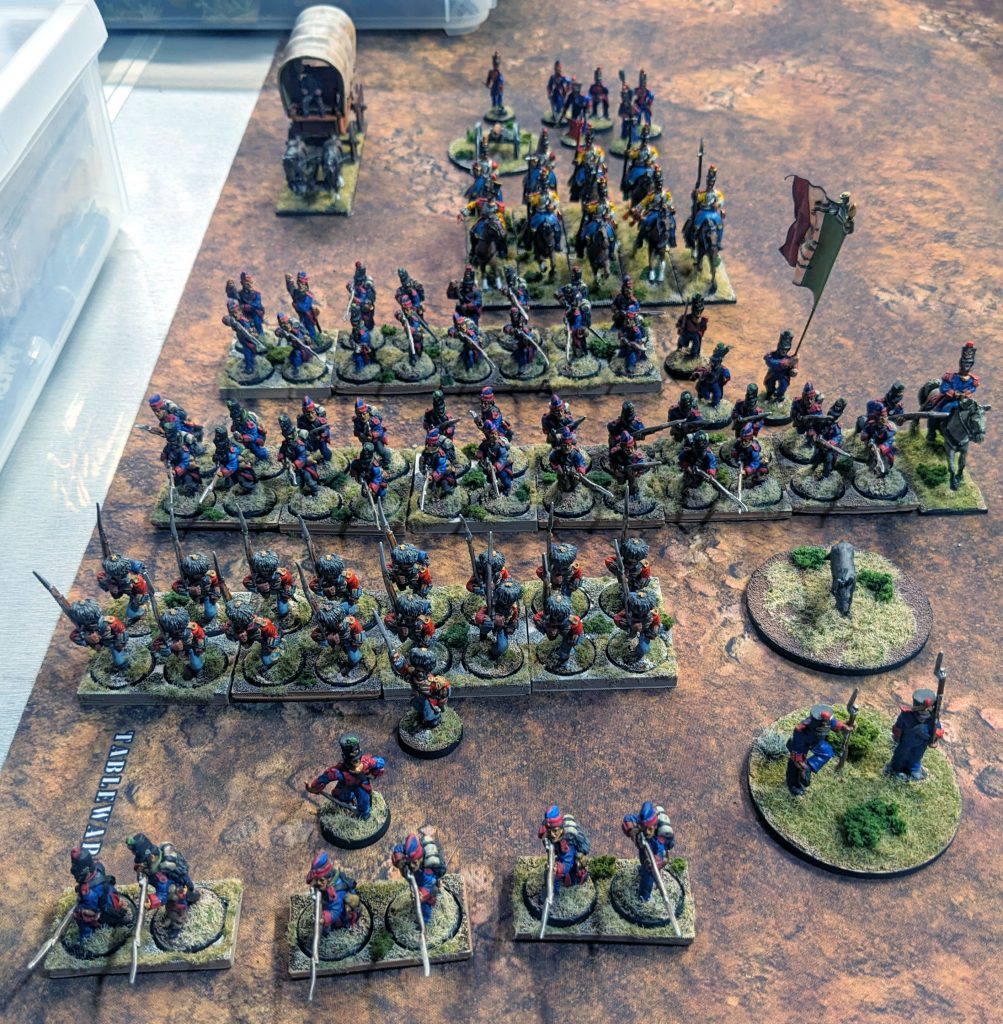
Mexican Army
The Mexican Army during this period was in hard times. The government of Mexico had gone through numerous coups, religious takeovers, and tons of leaders. The state was poor, as could be expected for a country that just earned their independence from a major European power just a few decades before.
The army was mostly made up of poor conscripts; Mexico’s soldiers were trained and motivated to fight, but were very poorly equipped and poorly led. In 1846 they were using leftover Napoleonic Wars smoothbore flintlocks from Europe. The uniforms they wore were even totally inspired by French Napoleonic uniforms, as Santa Anna wanted his troops to evoke the flair and élan of the French army.
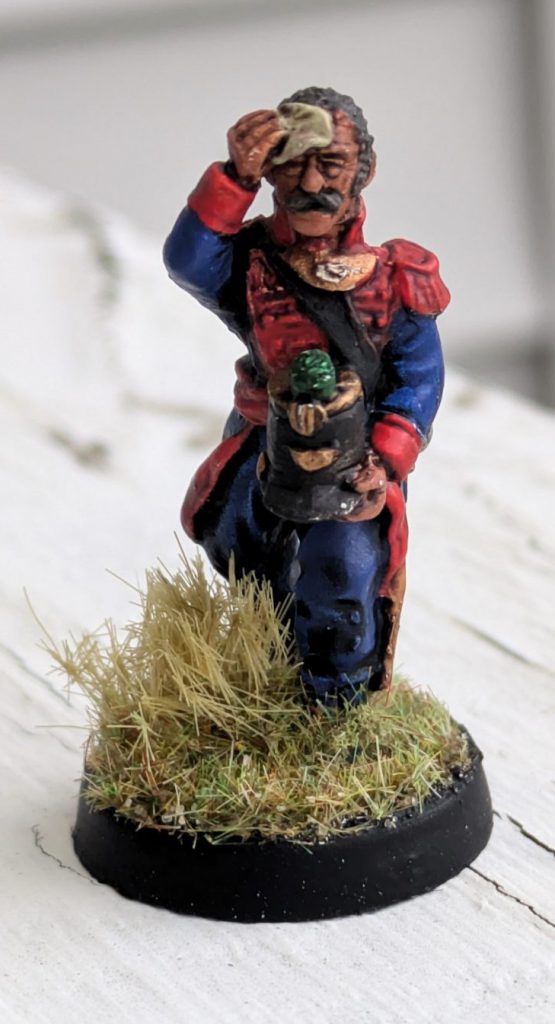
While the Mexican Army used Napoleonic muskets that might have worked under normal circumstances, the black powder that the Mexican Army was supplied with from Mexican internal sources was absolutely awful. Sources from the period state that Mexican soldiers would sometimes have to triple-load their muskets in order to propel the ball out, but then shoot from the hip in order to not break their shoulder from the kick of the gun. Their cannons were also very old – many were fortress guns that the Spanish had left in 1821.

For this force I’ve chosen to make a force of light infantry. Some light infantry in line, some light infantry skirmishers. If I had chosen not to use light infantry in line, the Mexican line infantry would have to double in number, as they’re conscripts and don’t have access to Sharp Practice. These units do have Sharp Practice, which allows them to fire and reload faster with the use of command cards, and Stubborn, which helps them fight fisticuffs better. I’m considering changing their Controlled Volley to ‘Yes’ because they’re trained well enough to do that, and I always forget the ‘First Only’ anyway.
These are Mexican light infantry models from 1st Corps. They’re great pewter minis that carry a lot of character. The flag is from FlagDude. In most games I use a formation of 24 and a formation of 16. The hardest part about leading these infantry formations is that they count as having fowling pieces – so when the enemy gets close they’re still only hitting on 5 + 6, because they’re at effective range, while the better armed US force are hitting on 4+5+6 at close range.
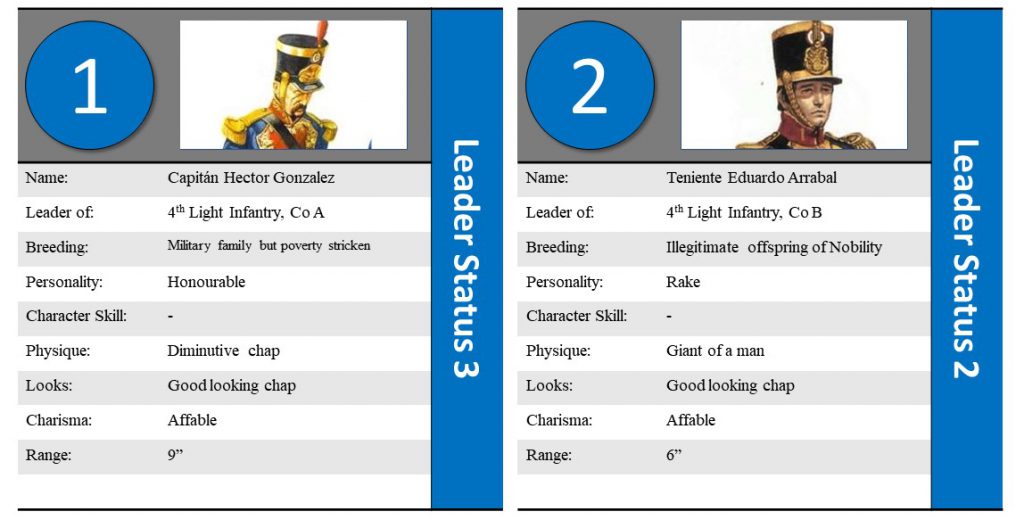
The officers are status 2 and 3. I like to have a ‘force commander’ at status 4, but the Mexican Army can’t really claim to have leaders of that stature here. Capitan Hector Gonzalez is an honorable military man, coming from the military but obviously having to serve in order to earn money for his family at home. He leads the larger formation, while Eduardo Arrabal leads the second formation – he’s good at doing tasks and talking to people because he’s huge, good looking, and affable.

The light infantry skirmishers that will screen the Mexican force are not actually Light Infantry – that is to say they don’t have that status in Sharp Practice. Light Infantry Skirmishers in SP are some of the best troops you can find.
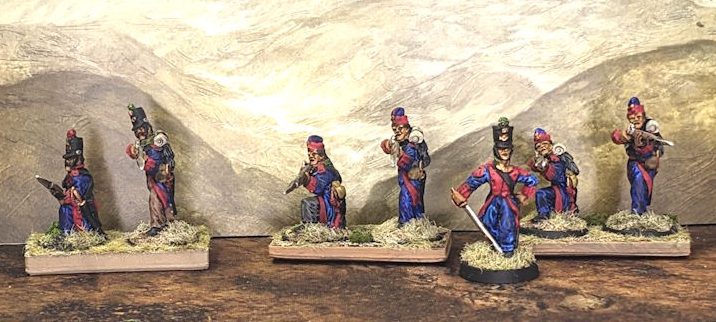
These guys do have rifles, but aren’t trained to be rangers, essentially. They do fight better because they don’t have fowling pieces, but don’t get them into close combat because they’re weedy coves. With the rifles they can Fire and take two actions to reload, or fire as a regular musket and take one action to reload using a ‘Tap Reload’.

The Grenadiers of the Supreme Power unit was made up of sons of Mexico City wealthy merchants. Santa Anna himself created the unit and recruited the soldiers. While they’re still stuck with the same poor equipment, they do have sweet Grenadier uniforms and are rated as Aggressive since they have something to prove.
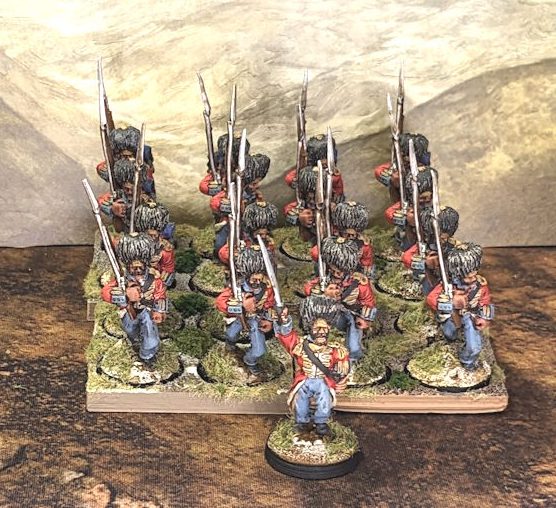
This is a formation of 16 soldiers, giving the Mexican force a large set of three formations and one skirmish screen.

Santino Botin leads the Grenadiers – he is definitely not an officer you want talking to locals or attempting to do Tasks. His father made him join the Grenadiers and paid for his commission because as such an awful person without the looks to get him by in society he didn’t have any other options.
The last unit that I usually bring for the Mexican force is a unit of Lancers.

These are scouting cavalry – not really a unit you want hammering straight into the front of a formed infantry formation. They’re fast and their lances do help in close combat, but they don’t have guns and are more useful as a screen or a way to threaten enemy deployment points. I am considering using a Movable Deployment Point to help these guys get where they want to go easier.

With yellow uniform jackets, these are possibly the most colorful uniforms I’ve ever painted. They’re awesome looking minis on the field and were great to clean up. I’ve since purchased a movement tray from Victrix that fits them perfectly.
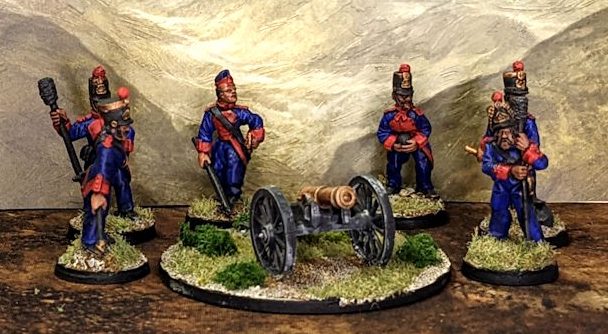
The last military unit I have for the Mexican Army is this artillery crew. I don’t use them often, choosing instead to use their cavalry, but they’re great minis.

These are the deployment points I use for the Mexican Army. The soldiers are from Boot Hill and I’m not sure where I got the burro.
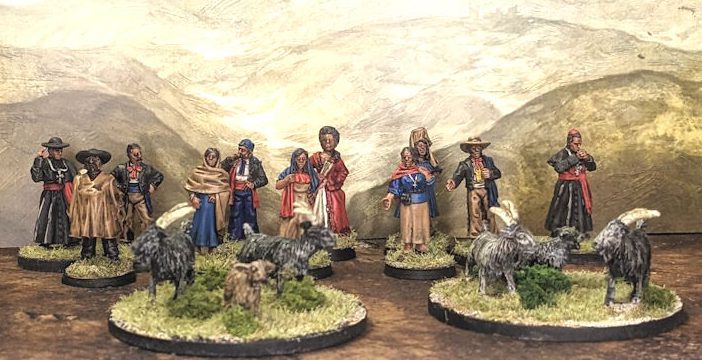
I’ve also painted these civilians (and I have more from 1st Corps to paint as well) from Boot Hill. They live in the towns and farms that we’ll be playing our games in.

US Army
The US Army during this time period had gone from a militia-based army in the early 1800s to a standing regular army. Standing armies were still frowned upon hard because Americans really didn’t trust that yet – even West Point was almost defunded because people didn’t see a reason for it.
The regulars that we’re using in this campaign were well-trained, motivated, and equipped with some of the best military tech in the world at the time. They did still have 1816/1822 flintlock muskets, but their artillery was top notch and used in innovative ways.
The American army did include many volunteer regiments who were less well-equipped, less well-uniformed, and poorly trained. They could not be trusted to perform nearly as well as the regulars.

Leading this force is Lewis Mitchell, a Captain in the 3rd US Infantry. He’s all around a great officer – leader status four, meaning he can push his troops upfield and rally a ton of shock, plus he’s huge, handsome, and charismatic. He’s been sent to Mexico to make his name and come back to the USA hopefully as a candidate for Colonel or Brigadier General.

The main difference between US Regulars and the Mexican infantry is they don’t have fowling pieces. When they get close they’re going to hit on 4+ with a heavy volume of fire.
These minis have the distinctive blue-gray uniform with dark blue m1839 wheel caps. There are a good number of poses from 1st Corps, including firing, loading, kneeling, charging, and port arms.

One of the newer units I’ve painted are 1st Corps’ US Dragoons. These are pewter minis with pewter horses so they’re an absolute unit to move around. In game they’re probably the best troops you can get – they can Tally Ho into Fisticuffs, they have Step Out 1 so they’re super fast, and they can deploy and fire. As Impact Dragoons you probably don’t want them deploying unless absolutely necessary – they’re amazing in Fisticuffs.

To give you an example – lets say this group is charging at full gallop at formation of two groups of regulars. They start with 12D6, then use one flag to Tally Ho, increasing their movement by 1D6 and adding 2D6 to their total. They’re one quality level higher than the regulars, so they add 2D6. They’re also aggressive, so they add 2D6 more to their pool, so they’re rolling 18D6 against 9D6 for the group of infantry plus one support. Absolutely immense.

The skirmishers are pretty basic regular skirmishers. They have Sharp Practice, which is almost universal among regular skirmishers.
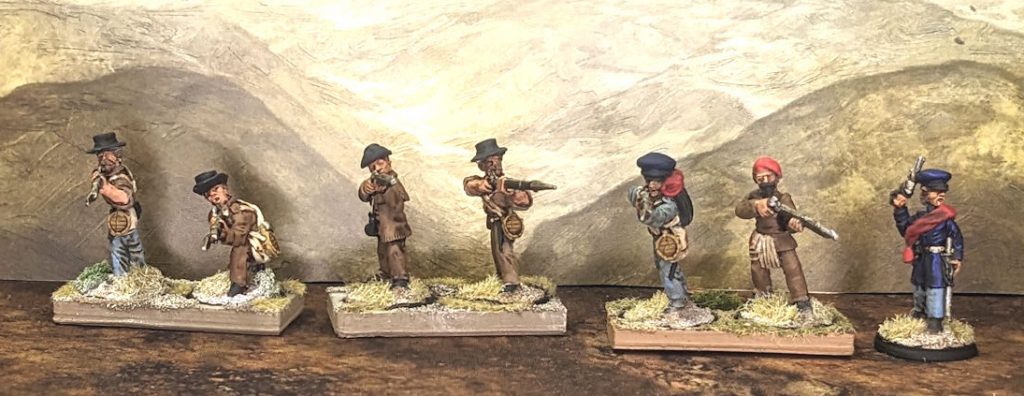
They’re clothed mostly in civilian clothing here but I do use regular uniformed guys as well.

Artillery was one of the differentiating factors for the US Army during the war. They had new weapons with new tactics that allowed them to rapidly deploy and suppress the enemy.
I’ve purchased horse artillery crews before and never painted any – they are pretty daunting – but since they’re so iconic to this conflict I knew I had to paint them. I grabbed a huge base from Renedra. This one is 230mm x50mm and all one piece, so I don’t have to worry about bases breaking apart or anything. I did want to use mini-rope to hook all the horses together accurately but it became too difficult, so I gave up on that part.
I have one deployment point so far for the US Army – a couple of local guides who are leading the army to the Mexican forces. I also painted two wagons for this conflict – one for Mexico and one for America, even though really they could be either one. You can see my review here.
New Rules
One of the neato things that I liked about Infamy, Infamy when I played it at HistoriCon was the use of special cards to give players abilities outside of the normal rules. They’re like random events but the player can choose when to play them. Sharp Practice v1 had a card deck like this, but v2 switched to command cards and abilities you could use in game with those command cards.
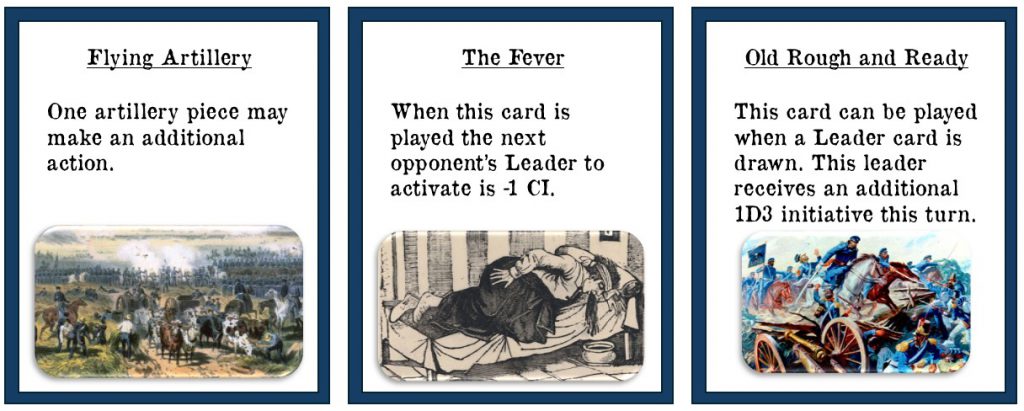
I wanted to add some special cards to my game just to see how it would go. They started a little too powerful, I think. The Fever originally just canceled someone’s activation, but I think that is definitely too powerful. Flying Artillery gave an artillery piece an additional move, but really they only want to move a little bit then setup.
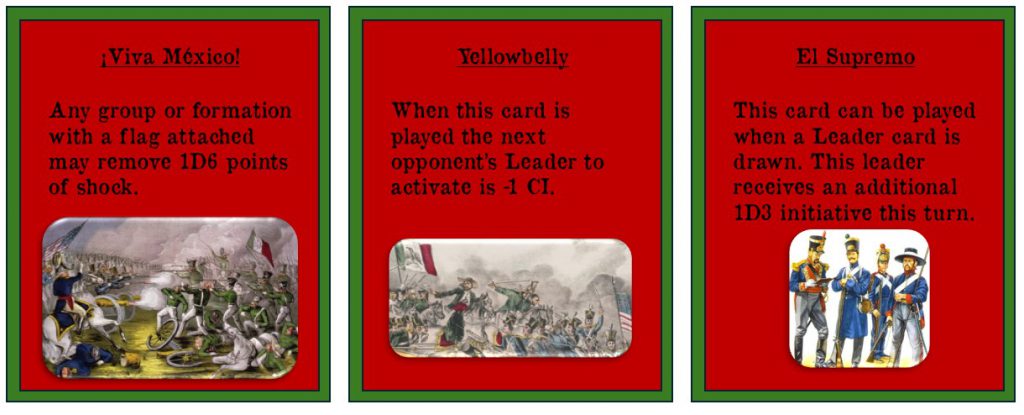
Originally each player had two copies of each card, but I think one copy of each card would work better. Perhaps in the future players will have to spend a flag to buy a card at random – it’d be interesting to test out.
Battle Report – The Collection
I’m currently writing a narrative programmed campaign (programmed means each scenario is written, with one following the other, no player interaction on a map or anything) that follows an American force after they’ve landed with Winfield Scott at Vera Cruz, marching to Mexico City. The Mexican Army is in retreat and may have different goals than pure military actions in each game.
Sharp Practice US-Mexican War scenario PDF
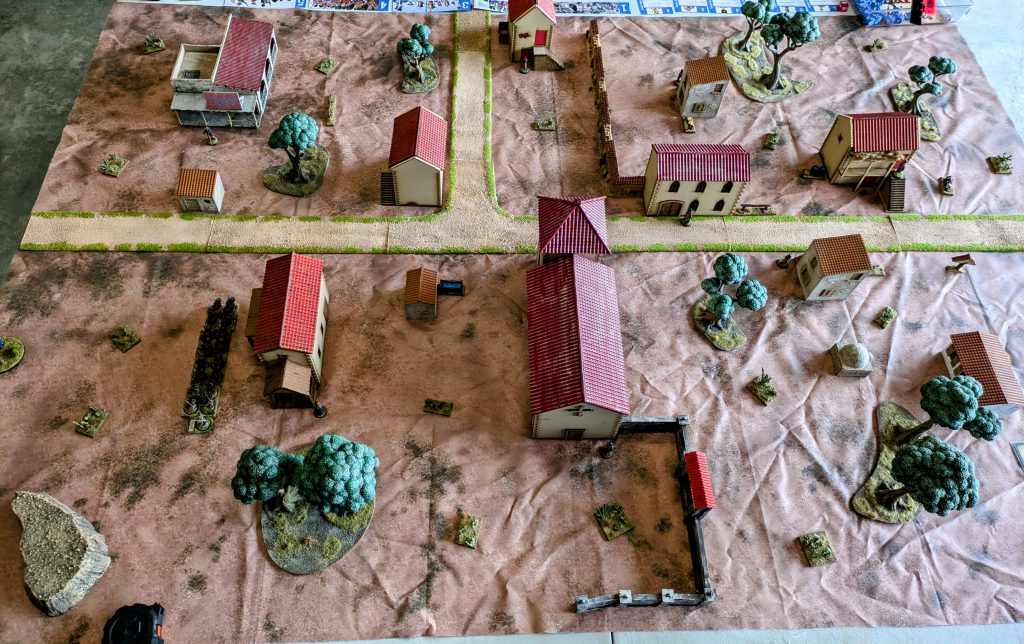
I ran this game at HistoriCon ’24 and the Mexican Army lost after having their overall commander killed in a one-sided fisticuffs – losing eight force morale total. I did shamefully forget to have the US players delayed in their deployment. I played it again with Ilor in my garage.

Early on, the Mexican forces moved up the field and did their best to find the relics they needed to collect. In order to do so, they had to move to each door and do a task roll of 10 total. In game terms, that means they move to the door one turn, then take a whole turn to roll 2D6 and try to get to 10.
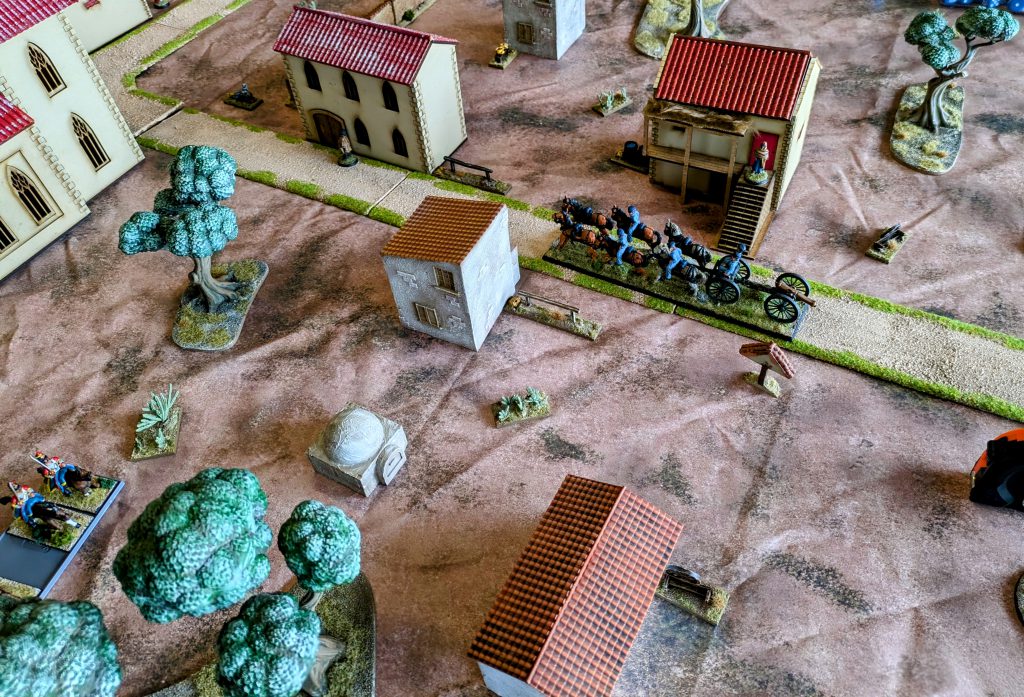
If they don’t get 10 the first time, they take another turn to search and add to the number until they get to 10. It simulates them moving around inside the building, respectfully looking for relics and valuable goods to take back to Mexico City.
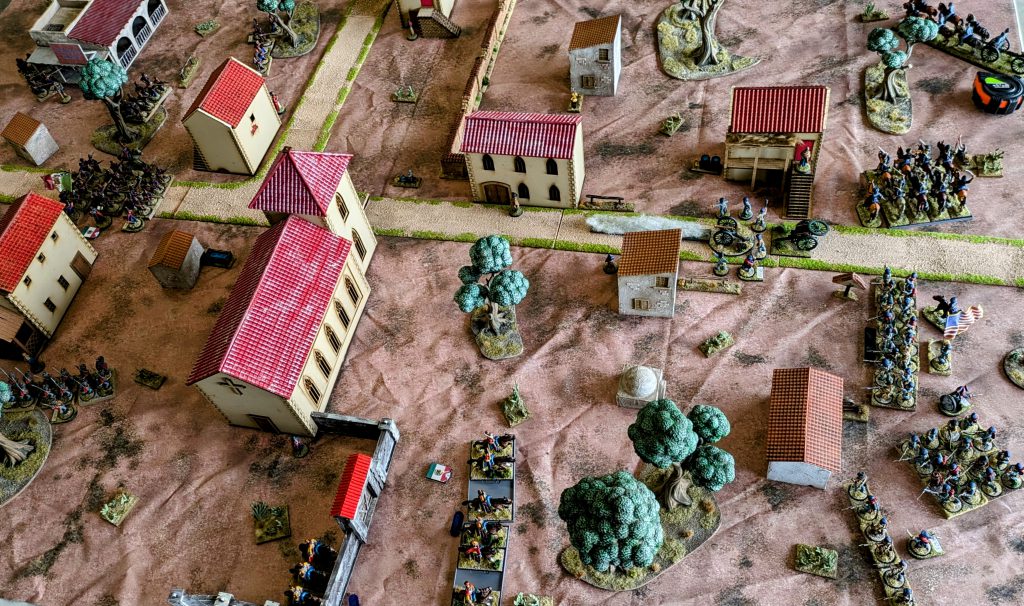
The Americans eventually did make it on the field, but not until the Lancer cavalry had pushed up almost to their deployment point. American artillery took the field via the road, intending to deny the extra movement to the Mexican infantry. They opened up with roundball on the Mexican infantry but didn’t manage much except some shock.

Here you can see the Lancers doing their job – screening the movement of the infantry way behind them, stopping up the American movement and keeping the relic hunters safe for a bit. The Lancers did actually destroy the skirmish unit and caused the attached officer to run away, causing a huge hit to US morale.

The Lancers caused the American regulars to have to move into line and volley them to push them back. They did enough damage that the Lancers broke and fled, not to return. While that was bad for Mexican Force Morale, now the Americans would have to move up field in unwieldy line formations.

Overall battlefield shot. Credit: Michael O “mugginns”Halfway through the game, the American artillery had setup to blast canister at the approaching Mexican infantry. They really boofed it, though. They did almost no damage and the Mexicans continued their forced march.
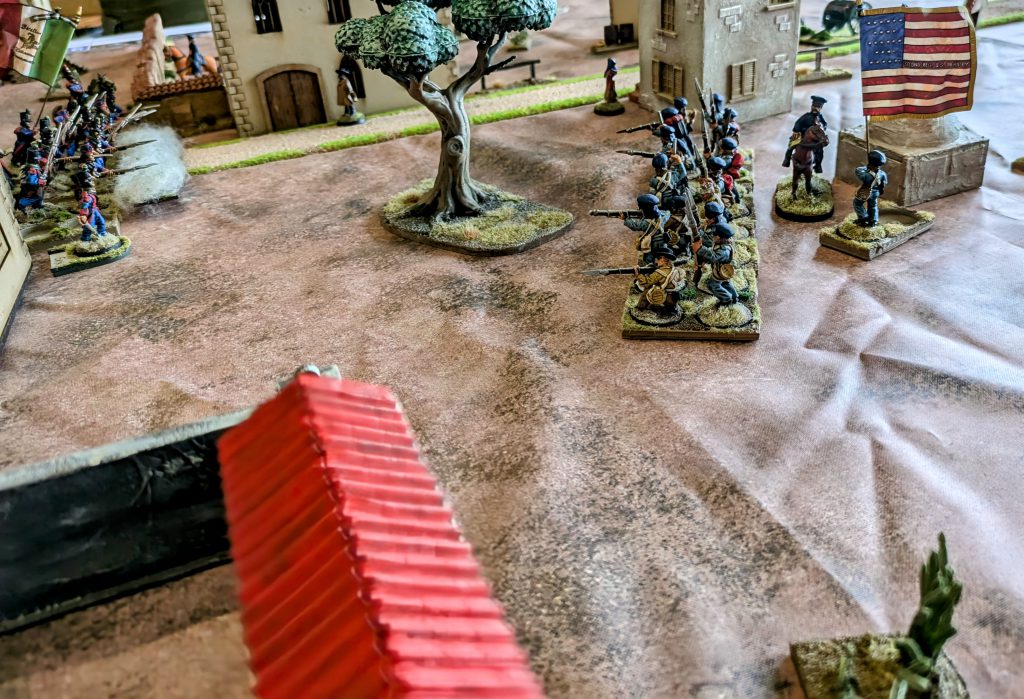
The American infantry did manage to get in line in the middle of the town and start moving toward the Mexican infantry, but not until the Mexican infantry had unleashed volleys on the American artillery, effectively suppressing it.
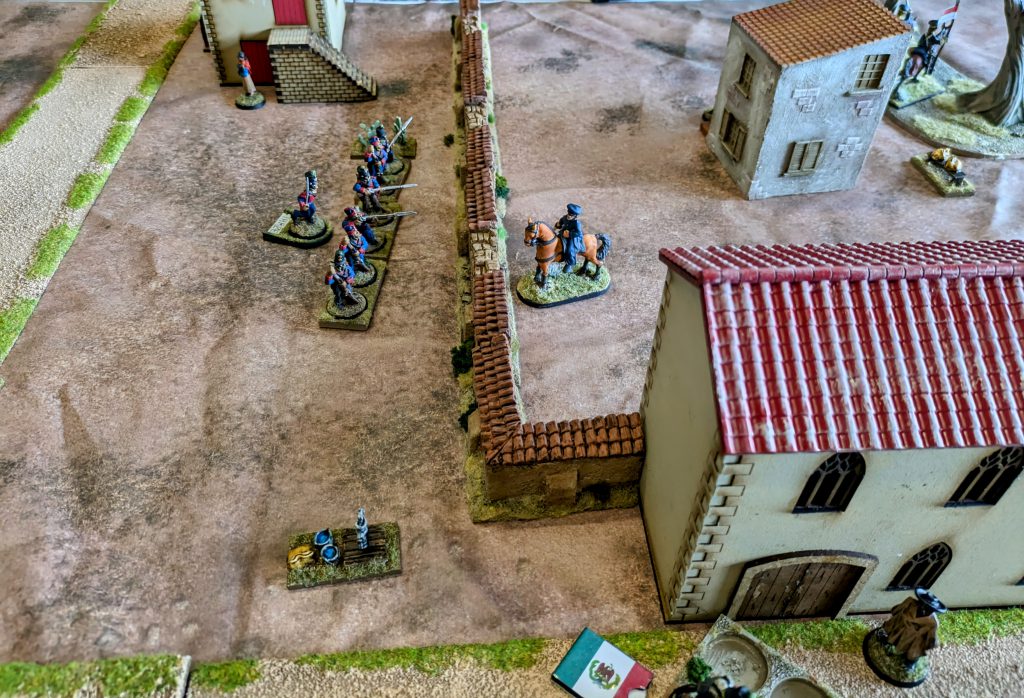
I didn’t get a picture of it, but the American luck continued to be poor as the Dragoons managed a charge into line infantry but failed to win the combat, rolling very badly. They were sent fleeing to the rear, while their officer, who had pulled up at the wall because his horse wouldn’t go over, was left by himself.

By now both sides were pretty low on Force Morale, but the Mexican force had managed to scrounge up five relics. The American infantry knew they couldn’t stop them from taking the relics back to Mexico City, but if they broke the Mexican Force Morale it could be draw if the player failed the roll.
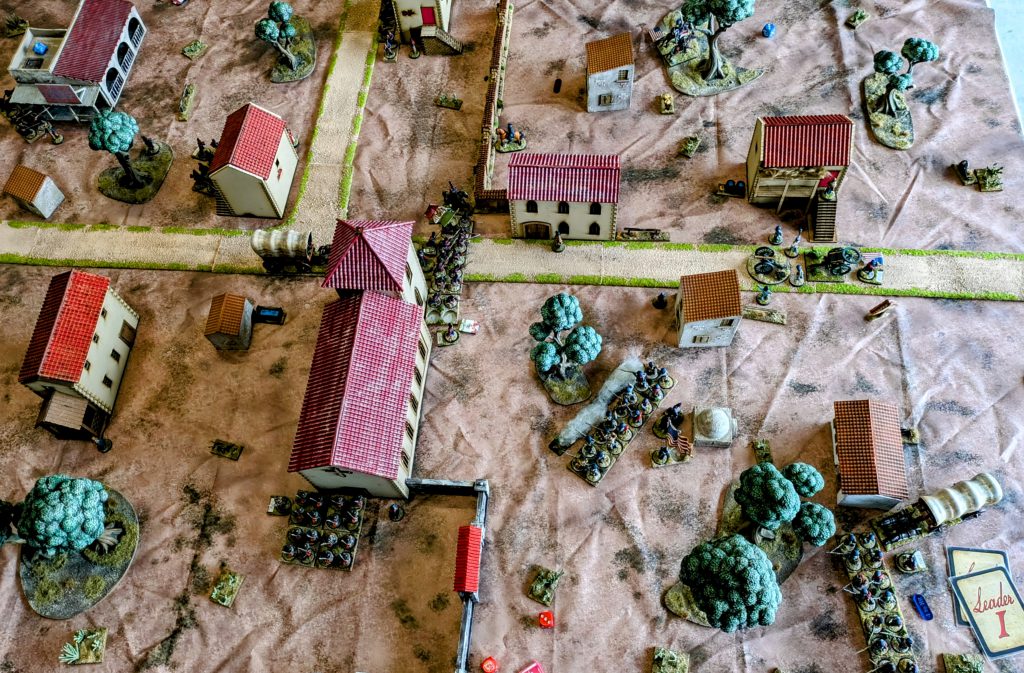
The Americans unleashed a few volleys then charged in – causing a loss of leader for both sides in the resulting fisticuffs – at which time both sides went to zero Force Morale. The Mexican player managed to roll under the number of relics they had collected and took the victory! Overall I couldn’t have asked for a better game – coming right down to the wire – so I was very happy with the outcome.
It was a tough scrap with both sides having some amazing moments. The American commander had failed to use his advantage – fighting close in with better weapons – until the very end. The Mexican player had done a great job of screening the guys doing the work in the back, and had a bit of luck with some really bad rolls from American artillery and Dragoons.
I still have some minis to paint for this period: Hussars of the Supreme Power, Activa Coast Guard, and US Volunteers. They’re all lovely models from 1st Corps. When I get done with those, it’s on to a new conflict.
Have any questions or feedback? Drop us a note in the comments below or email us at contact@goonhammer.com. Want articles like this linked in your inbox every Monday morning? Sign up for our newsletter. And don’t forget that you can support us on Patreon for backer rewards like early video content, Administratum access, an ad-free experience on our website and more.











